Please visit the story on The New Yorker website for the full interactive experience
This piece was supported by the Pulitzer Center and the Eyebeam Center for the Future of Journalism.
Xinjiang is one of the most ethnically diverse regions in China. In 2017 and 2018, authorities detained roughly a million Uighurs, Kazakhs, and other predominantly Muslim minorities in secret “reëducation centers.” In 2019, they claimed that detainees had “graduated.” Evidence shows that many were sentenced to long prison terms or forced labor instead. It is likely the largest internment of ethnic and religious minorities since the Second World War.
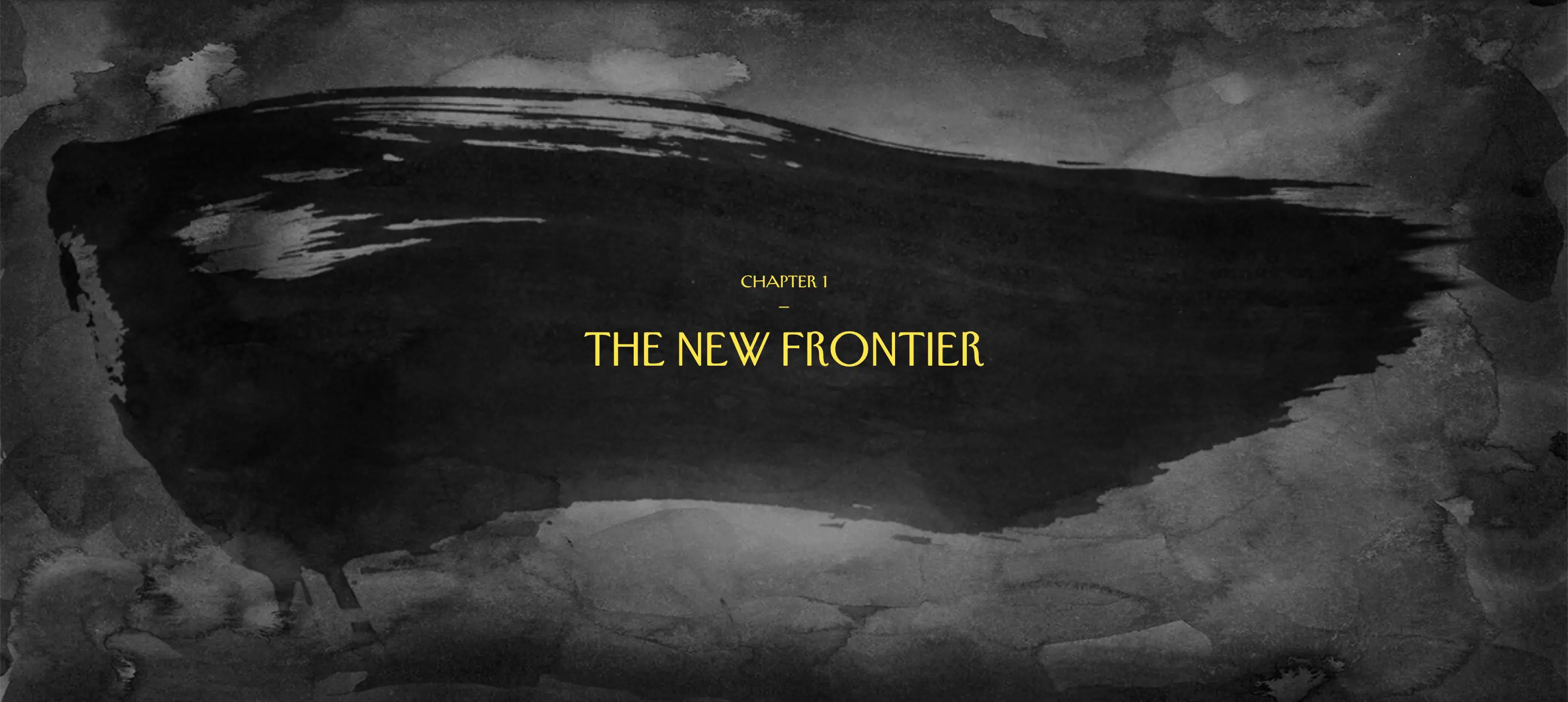
In the spring of 2017, Erbaqyt Otarbai, a forty-three-year-old truck driver living in Kazakhstan, crossed the border into China to accept a job with a mining company in Xinjiang. His wife had recently undergone surgery to remove kidney stones, and he needed money to cover her medical expenses. For the next three months, he crisscrossed the region, hauling iron ore in a hundred-ton truck. By August, he had saved up enough to pay his debts.
On the morning of August 16th, the county police in Koktokay, near the mine in northern China where he was based, summoned him to a meeting. At the police station, officers led Otarbai to a room lined with spongy, yellow soundproofing. There was a metal chair with arm and leg restraints, but the officers didn’t make him sit in it. One officer asked him questions in Chinese: When had he moved to Kazakhstan? For what purpose? With whom did he communicate? Did he go to a mosque? Did he pray? Otarbai answered honestly. He hadn’t done anything wrong and wasn’t worried. After two hours, the officers released Otarbai but kept his cell phone, saying that they would review its contents.
Later that evening, Otarbai drove a truckload of iron ore about four hundred miles south from Beitun, near the Mongolian border, to a processing plant outside of Ürümqi, Xinjiang’s capital. He arrived around dawn, after an eight-hour journey. While he was waiting to unload his cargo, he heard a knock on the side of his truck. It was a fellow-driver, who said he had received a call from the company dispatcher. The police were coming to pick up Otarbai, who should unload his truck and wait.
When officers arrived at the processing plant, around noon, they told Otarbai that they’d found a problem with his household registration. They would drive him to Tacheng—about six hours away—to get it fixed. As he rode away in the police car, Otarbai realized that he’d forgotten his wristwatch in his truck. The police told him not to worry. “We have some paperwork to fill out, and then you’ll be free and your truck will be waiting for you,” he recalled one of the officers saying. On the highway, they switched on the lights and the siren. Otarbai began to feel nervous.
Otarbai was born in a rural part of northern Xinjiang, near the borders that China shares with Kazakhstan, Russia, and Mongolia. His family’s roots were Kazakh, and, although he grew up speaking both Kazakh and Chinese, Otarbai felt closer in language and custom to Central Asia than to Beijing or Shanghai. Kazakhs are one of China’s fifty-six officially recognized ethnicities and the third-largest ethnic group in Xinjiang. Uighurs, the largest ethnic group in the region, like Kazakhs, speak a Turkic language and are predominantly Muslim.
As an adult, Otarbai found himself drawn to Kazakhstan, where members of the Kazakh diaspora in China had increasingly migrated, particularly after the country declared its independence from the Soviet Union, in 1991. After Otarbai got married, he moved to his wife’s home town, Tacheng City, about eleven miles from the Kazakh border, and changed his household registration to match hers. Then, in 2011, Otarbai moved to Kazakhstan to build a house for his family. He found work driving pipeline segments across the border for a Chinese oil company. His family followed several years later, but they continued to travel back and forth to see relatives and take advantage of better health care in China.
Beginning in 2015, however, crossing the border became fraught. Otarbai and his wife travelled to China for the birth of their second child. When the family tried to return to Kazakhstan, border guards held Otarbai behind. There were problems with his paperwork, which took three days to resolve, while his family waited in a hotel in Kazakhstan. He suspected that the change in his household registration had flagged him as suspicious, so he decided to apply for Kazakhstani citizenship. In April of 2017, Otarbai and his wife visited China for her kidney-stone removal.
When he returned to China a month later to work for the mining company, his application for citizenship in Kazakhstan was still pending. Border authorities confiscated his Chinese passport. They told him that the government had issued new instructions for cases like his. Local officials would hold his passport at the police station in Tacheng, where his household was still registered, until he was ready to return to Kazakhstan. But before he could retrieve his passport, the police had detained him on August 17th, loaded him into a squad car, and turned on the siren.
The officers took Otarbai to the Tacheng police station. He was surprised to see that the building, which he remembered from his time living in the city, had been outfitted with new metal security doors and a fingerprint scanner. Around 1 a.m., Otarbai was interrogated again. This time, he was secured to the same type of chair he’d seen in the Koktokay police station, which he later learned to call a “tiger chair.” His arms and legs were cuffed. When he asked what he’d done wrong, the officers replied that they were simply following instructions. One officer pointed to a camera mounted on the wall. “They are watching us,” he said.
Otarbai learned that the police had found WhatsApp, a messaging client that is blocked in China, on his phone. Otarbai protested that the app was common in Kazakhstan, where he now lived. The officers asked if he knew what he had saved in his WhatsApp account. Otarbai immediately understood what they meant. In Koktokay, he’d told the police that he didn’t pray regularly. Now he remembered that there were a few videos of imams preaching and inspirational images related to the practice of praying five times a day. “I know there is some religious instruction,” he told them. “I know it is there.”
Otarbai’s interrogation ended soon after he acknowledged his phone’s contents, and the police took him to a nearby hospital for a medical checkup. Although he was the only patient there in shackles and handcuffs, he still hoped that he would be freed. Instead, the police took him to Tacheng’s pretrial detention center. He spent the next three months there, sharing crowded jail cells with as many as twenty-two other prisoners. By his own account, Otarbai was a badly behaved detainee. He shouted at guards, demanding his release, which led to beatings. During one encounter, a guard told Otarbai that he would rot in jail, then struck his head with a metal baton, causing him to bleed. “Nobody interrogated me,” he said. “Nobody told me what was happening.” He assumed his detention was a mistake that would soon be corrected. On November 22nd, three months after Otarbai entered the detention center, police officers read aloud a list of prisoners who would be transferred to a “political learning center.” More than two dozen detainees were handcuffed, shackled, hooded, and loaded into police minivans. Otarbai was among them.
The region now known as Xinjiang is the homeland of several Central Asian peoples, including Uighurs. From the Bronze Age into the 18th century, nomadic Hunic, Mongol, and Turkic powers vied to control the area’s fertile lowland oases. In the 1750s, a Chinese kingdom, the expansionist Qing Empire, conquered the region.
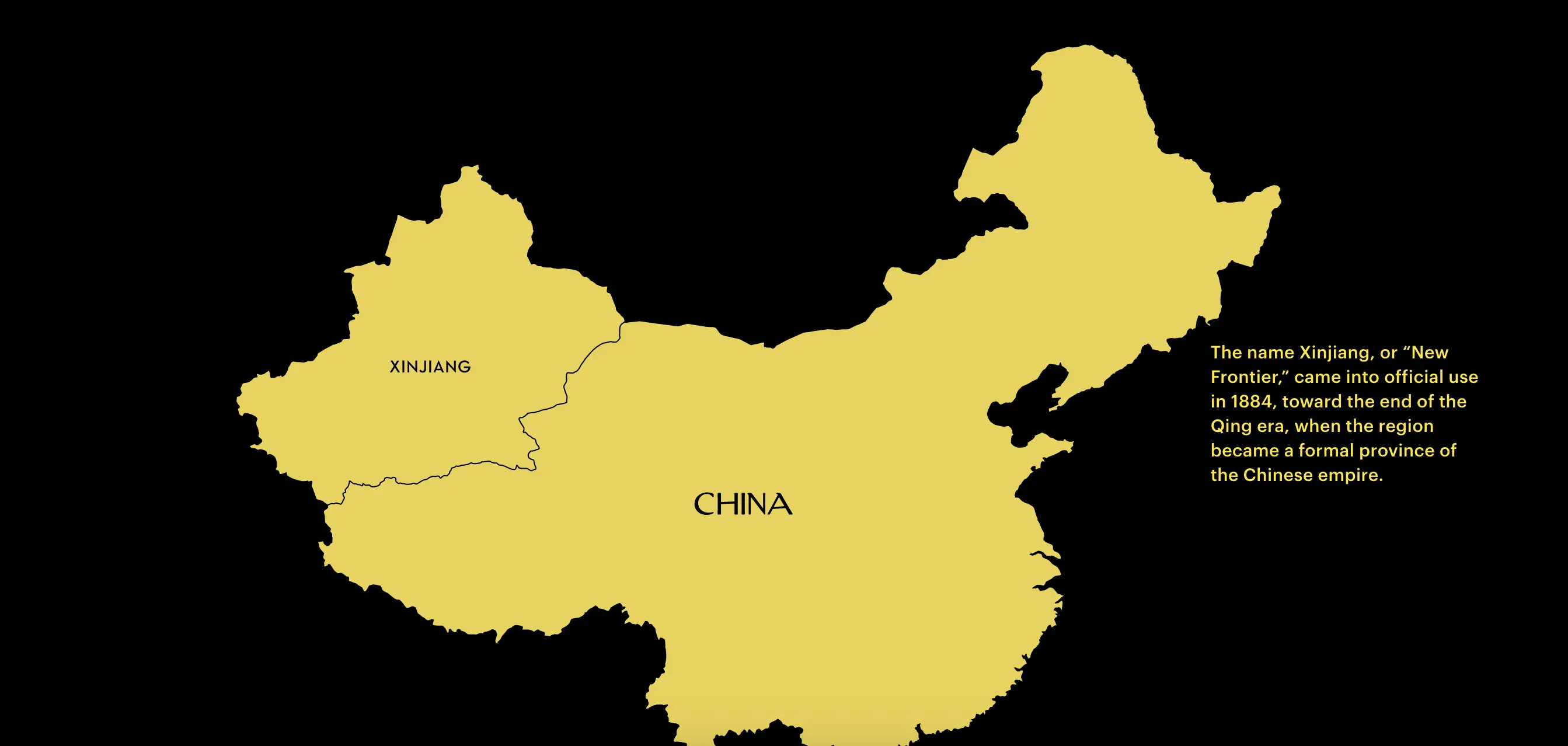
In the first half of the 20th century, nationalists twice attempted to create an independent country named East Turkestan. Later, in the 1950s, China’s Communist rulers declared the Xinjiang Uighur Autonomous Region the second of an eventual five autonomous zones for ethnic minorities. Today, Xinjiang is China’s largest region, bordering eight nations. It is also one of the most ethnically diverse regions in China. Xinjiang is home to roughly 13 million Uighurs, 9 million Han Chinese, and 1.5 million Kazakhs, as well as Hui, Kyrgyz, and Mongolian populations. In the spring of 2017, authorities in Xinjiang began detaining thousands of Uighurs and other Turkic and Muslim people. By 2018, as many as a million people were held in a vast network of prisons and “reëducation centers.” Satellite images suggest that there may be more than 380 detention facilities in Xinjiang.
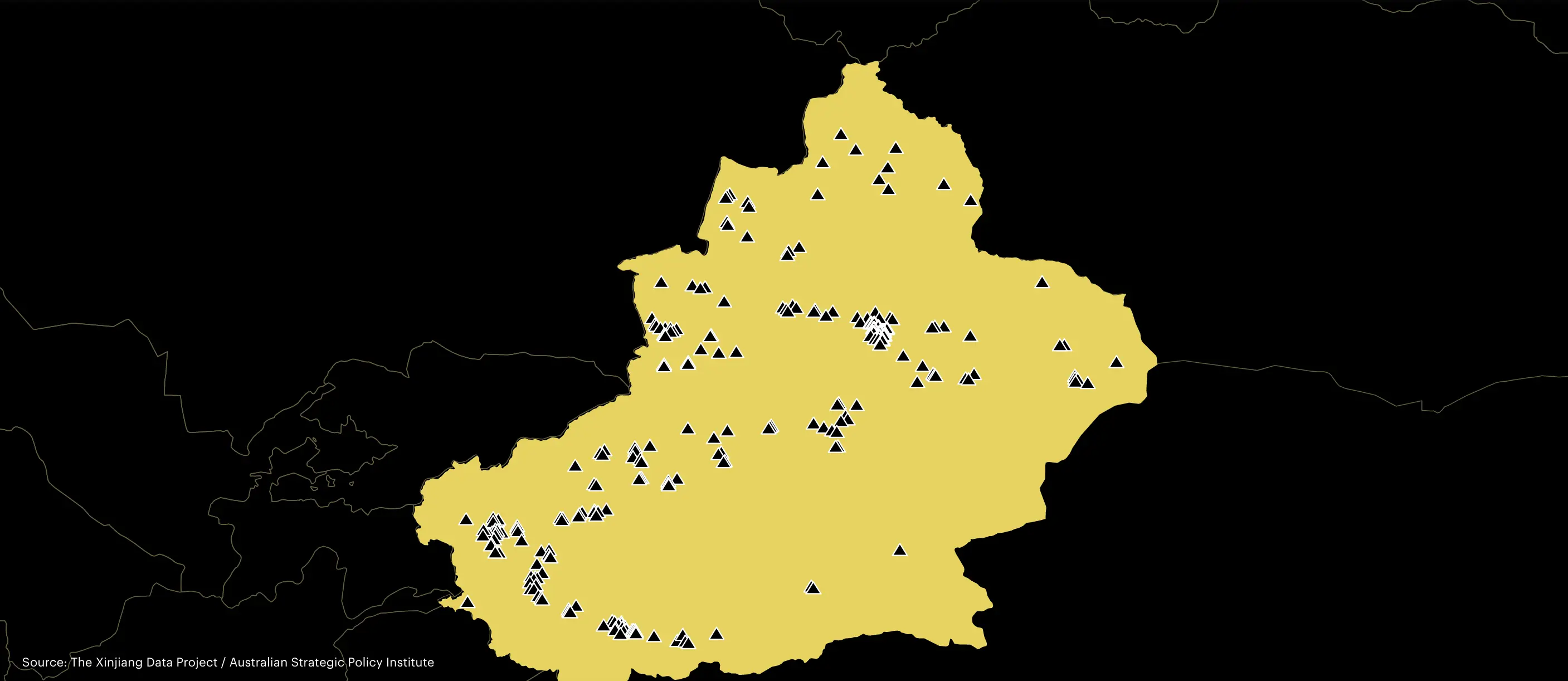
In the nineteen-fifties, China’s new Communist government began encouraging migration to Xinjiang, a region leaders viewed as sparsely populated, underfarmed, and mineral-rich. Most of the settlers belonged to China’s dominant Han ethnic group. The government developed a sprawling system of state-owned agriculture, factories, mines, and oil fields in the region, all overseen by Han settlers. Breathtaking economic growth followed, and the area’s ethnic makeup underwent a profound change. In 1949, Han Chinese made up about five per cent of the Xinjiang population. By the early nineteen-eighties, they made up around forty per cent.
Many Uighurs and Kazakhs saw the government’s development policies as unfairly benefitting the Han newcomers. Some Kazakhs left Xinjiang for Kazakhstan, which was then still under the control of the Soviet Union. For decades, the Soviets supported calls from Uighurs for independence. By the nineteen-nineties, some Uighurs felt they were becoming marginalized in their own homeland. Inequality was rampant and fell largely along ethnic lines.
In 1990, clashes between Uighur dissidents and the police left more than twenty dead. Several years later, the Chinese government débuted the first of a series of “Strike Hard” campaigns against the “three evils” of terrorism, extremism, and separatism. Islam became a matter of state concern. For centuries, the dominant cultural identity in Xinjiang had been an amalgam of Turkic and Muslim traditions. Beginning in the late nineteen-nineties, imams had to undergo training and state certification in order to practice. Religious weddings and funerals became highly regulated affairs, requiring written permission from the state. After the September 11th attacks and the rise of America’s war on terror, the Chinese government changed its rhetoric to emphasize terrorism and blamed Uighur separatists for a series of attacks on Chinese security forces.
On July 5, 2009, around a thousand people gathered in Ürümqi to protest the deaths of two Uighur migrant workers in Guangdong, a manufacturing province on the coast of the South China Sea. The two men died in a brawl after a rumor spread that Han women working in a toy factory had been raped by Uighurs. Initially nonviolent, the protests devolved into riots and clashes between Uighur and Han residents. Nearly two hundred people were reported dead by state media; however, Uighur deaths were likely undercounted. The riots triggered a region-wide crackdown on all expressions of Uighurness.
More violence ensued. In 2013, a family of Uighurs drove a sport-utility vehicle into a crowd at Tiananmen Square, in Beijing, killing two tourists and everyone in the car. The following year, more than thirty people were killed, and more than a hundred injured, in a coördinated knife attack at a train station in Kunming, in Yunnan Province; the authorities blamed Uighur separatists.
After the Kunming attack and other incidents of violence, the government declared a “people’s war on terror.” In 2014, a region-wide system of roadblocks and checkpoints went up, and Uighurs who lived in Xinjiang’s urban centers were required to return to their home towns and receive new checkpoint passbooks, called “people’s convenience cards,” which severely restricted their freedom of movement. By 2016, even Uighurs with passbooks could no longer leave their home towns. Later that year, many in the southern portion of the region had their passports confiscated, making travel abroad nearly impossible. Kazakh and Hui people began to find themselves under surveillance as well. Chinese state social-media accounts increasingly reported on a “reëducation” campaign for Uighurs.
In 2017, detentions of Uighurs, Kazakhs, Hui, and other minorities began to escalate. The first wave targeted Uighur imams and the religiously devout. Soon, prominent academics, novelists, and film directors were also taken into custody. Police and security officers used broad pretexts to justify the detentions, including travelling abroad, having a beard, and owning a prayer rug.
Scholarly estimates of the size of Xinjiang’s internment drive—called the Transformation through Education program by Communist Party officials—fall in the neighborhood of a million extrajudicially detained people, a figure disputed by the Chinese government. An internal report by Xinjiang’s agriculture department, taken at the height of the internment drive, lamented that “all that’s left in the homes are the elderly, weak women, and children.” It is likely the largest internment of ethnic and religious minorities since the Second World War. After leaving the camps, some detainees are forcibly transferred to farms and factories, or kept under house arrest. Some ethnic minorities who aren’t sent to camps are sentenced to long prison terms. In a joint letter last September, twenty-three human-rights groups said that they believe the Chinese government’s actions may meet the U.N. definitions of crimes against humanity and genocide. Chinese authorities, however, argue that they are necessary tactics in a grave contest of survival, which one textbook promoted by the Ministry of Information describes as a “zero-sum political struggle of life or death.” Initially, the Chinese authorities managed to keep the scope of their actions largely secret. As a result, when Otarbai began working for the trucking company he had little sense of the danger he faced.
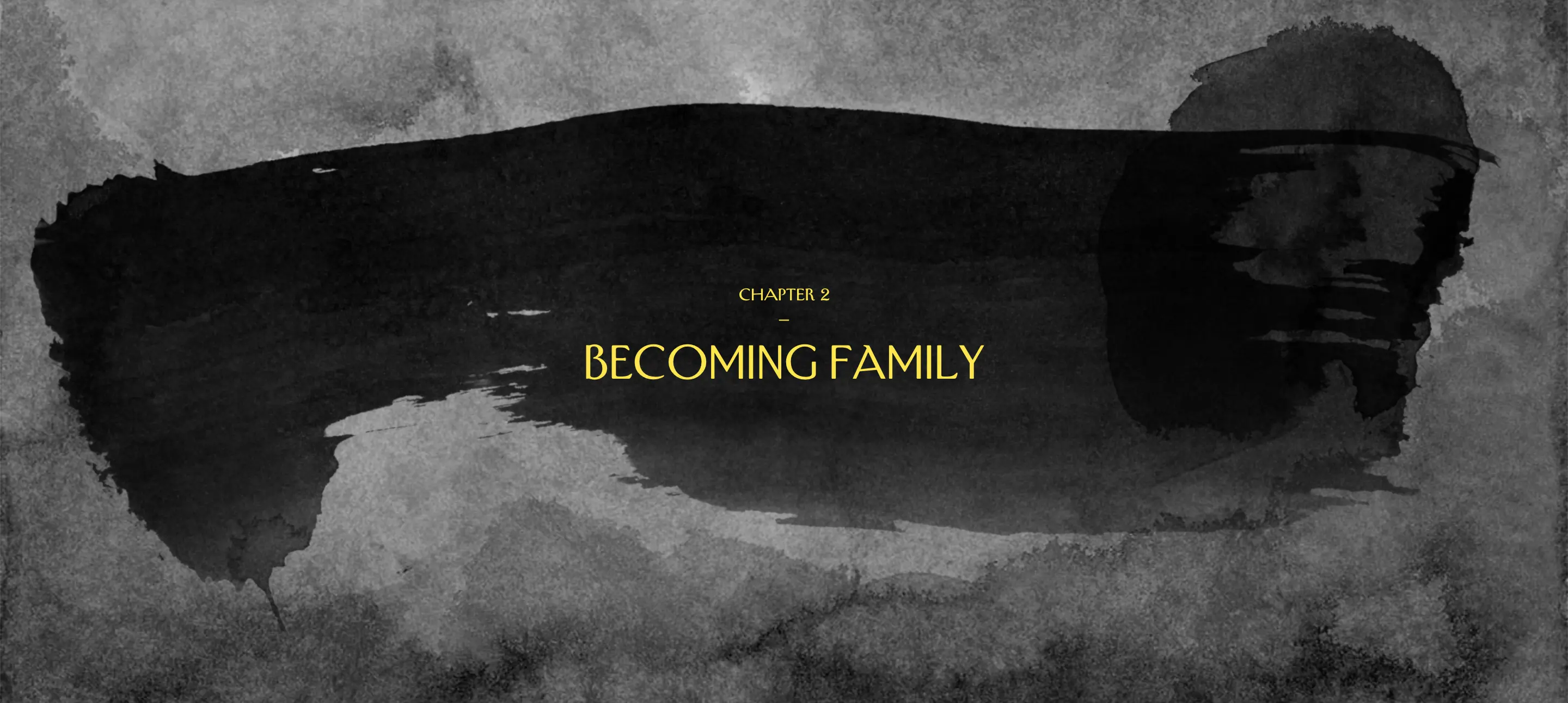
In May of 2017, around the time Otarbai arrived in Xinjiang, a Kazakh woman named Aynur, who asked to be identified by only her first name, returned to China as well. Born in 1964 in a small Xinjiang village near the border with Kazakhstan, Aynur married Nurlan Kokteubai, a math teacher, when she was twenty-two. She joined her husband in Akkoi Farm, a neighboring village in Chapchal County, and started teaching at the primary and middle school where he worked. They had three children together. After Aynur retired from teaching, in 2011, the family moved to Kazakhstan, where they lived off the pension that Aynur received from China.
In early 2017, Aynur began receiving telephone calls from the Party secretary of her former school, who told her that she needed to return to Akkoi Farm. It wasn’t clear what he wanted, but he called and wrote her on WeChat incessantly. Finally, she acquiesced. “They just said I would stay for two weeks and then go back,” she said. After she crossed the border, she went to her former school, where the Party secretary confiscated her Chinese passport. Local authorities told her that everyone with a registration in Akkoi Farm, including her husband, needed to come back to cancel their household registration. She stayed with her brother-in-law in Akkoi Farm; three months later, her husband crossed into Xinjiang to join her.
The changes he saw in his home town alarmed him. Surveillance cameras and police checkpoints had become ubiquitous in Xinjiang. Between 2016 and 2017, authorities advertised more than ninety thousand police and security jobs and built more than seven thousand police stations. In towns and villages across Xinjiang, residents described seeing armed guards, metal detectors, and police patrols in armored vehicles. In Akkoi Farm, seemingly every house now flew a Chinese flag. Police officers barged into homes, collecting prayer rugs, Qurans, and works of Kazakh literature. Sometimes, they burned these items in people’s yards.
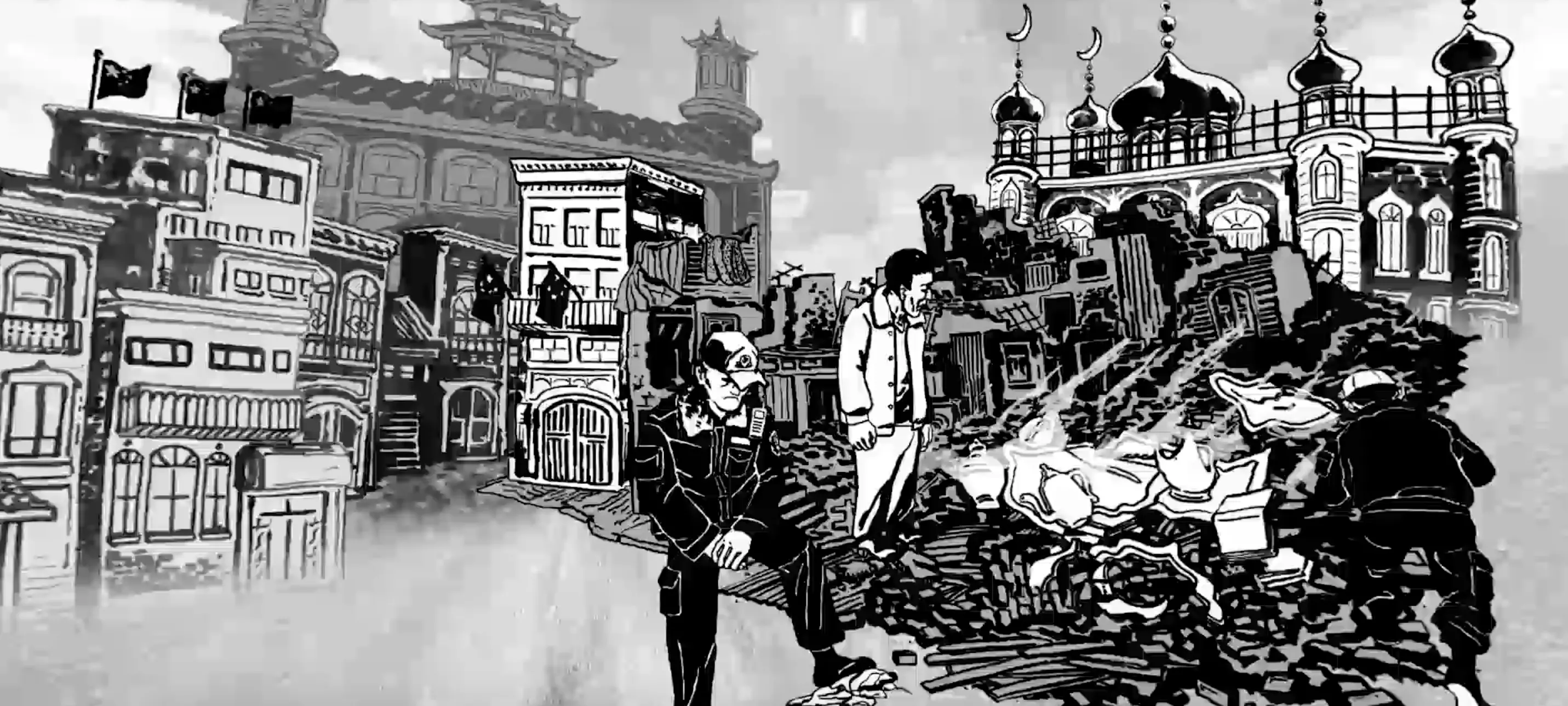
Authorities removed a crescent-moon finial from the dome of a village mosque. In the cemetery, tombstones inscribed with Perso-Arabic script were demolished. Kokteubai searched for the markers where his parents were buried.
They had been destroyed.
Less than a month after Kokteubai reunited with Aynur, the police summoned him to a meeting. Several hours later, Aynur received a phone call from her husband. He said police officers were taking him to a nearby secondary school that had been turned into a detention camp. He asked her to bring him some warm clothes.
A wall topped with barbed wire surrounded the school. At the front gate, Kokteubai waited for Aynur under guard. She brought him socks and underwear and took his phone, then watched him disappear into the facility. Authorities made Aynur sign a document from the county security bureau. “Notice to family of the student-trainee,” the document reads. “In accordance with Article 38 of the Xinjiang Uighur Autonomous Region Measures to Implement the ‘People’s Republic of China Anti-Terrorism Law,’ our bureau has, from the 6th of September, 2017, started education and training for Nurlan Kokteubai as he is”—the next section of the form was handwritten—“under suspicion of having dealings with individuals suspected of terrorist activities.”
The charges baffled Kokteubai. To his knowledge, he had never met a terrorist. On his second day of detention, a member of the camp administration came to see him. Kokteubai asked when he would learn what he was accused of doing. He was surprised to learn that he wouldn’t be questioned at all. “If you hadn’t committed a crime, you wouldn’t have ended up here,” the administrator told him. “So there is something you are here for.”
In 2016, Xinjiang’s Party secretary—a soon-to-be Politburo member named Chen Quanguo—imposed detention quotas. (Chen did not respond to a request for comment.) The quotas may have led authorities to coax Kazakhs who, like Aynur, were living abroad back to Xinjiang with vague but insistent messages. Chen, who had previously overseen a crackdown on civil society in Tibet, issued a directive to “round up everyone who should be rounded up.”
While Aynur’s husband was detained, Akkoi Farm officials required her to attend Chinese-language classes for four hours every day. For months, she heard nothing from her husband. Communist Party cadres showed up unannounced at the house where she was living and stayed for days at a time. As many as four strangers might appear, eating meals with Aynur and her relatives. When one group left, it was replaced by another. “They would interrogate us, mainly me, asking me what I was doing, why we went to Kazakhstan—they would ask about everything,” she said. After several weeks, the round-the-clock surveillance stopped, but cadres who called themselves Aynur’s “older siblings” continued to visit each week.
The cadres were part of China’s Becoming Family program, which began in 2016. More than a million civil servants have been placed into the homes of minority families in Xinjiang in order to “Visit the People, Benefit the People, and Bring Together the Hearts of the People,” according to one government slogan. The cadres are Party members, usually ethnic Han, sent to monitor and assess Turkic and Muslim families, instructing them in political ideology and Han cultural norms. Muslim men and women are pressured to drink and smoke. Hand-washing pitchers are confiscated and put on display as contraband, and cadres discourage residents from using traditional furniture. A 2017 report by the Communist Youth League of Xinjiang corrects Uighur families who eat or study at a traditional low platform, called a supa, because it is “inconvenient.” The cadres are enjoined to present their hosts with modern tables and rice cookers, gifts to help them advance toward a “healthy civilization.”
Sholpan Amirken, a hairdresser from northern Xinjiang who married into a prominent religious family, told me that after several of her husband’s relatives were detained in 2017, a male Han cadre came to stay at her house. He advised Amirken and her husband, both of whom are Kazakh, to dispose of books written in Arabic, so she burned them. He also ordered her to take down wall ornaments with Kazakh phrases—“May Allah Bless You,” “May the Roof of Your House Be High”—along with embroideries of mosques. The cadre visited for days or weeks at a time, she said, always bringing luggage and sleeping in the main house. Amirken was nervous around the cadre, who came even when her husband, a long-haul truck driver, like Otarbai, was away. She began to sleep in a guest house. “We considered him a spy,” she said.
In time, though, Amirken began to sense that some of the cadres had been pressured into the arrangement. “They have to make video calls from the house and report that they are there,” she said. “They are also doing it unwillingly.” Her cadre was far from the worst. Others, she said, “were very pleased with their jobs.” She had heard that some cadres threatened people with detention in the camps. At one point, fearing that her own detention was imminent, Amirken told her husband he would have to take care of their children. Human Rights Watch reported that children whose parents are both detained are institutionalized in state-run boarding schools where they must speak Chinese.
Forced assimilation is a long-standing fear among Uighurs, Kazakhs, and other minorities in Xinjiang. For years, state media outlets have published uplifting stories about interethnic marriages between Han men and minority women, and offered cash rewards to couples for the first five years of their marriages. These relationships have raised fears of coercion. Since 2017, authorities have also pressured hundreds of thousands of Uighur women to get I.U.D.s, have abortions, and undergo sterilization, the Associated Press reported last year. In Hotan, a city in Xinjiang where the population is almost entirely Uighur, authorities instituted a “free birth-prevention surgery” program, which aimed to sterilize more than a third of all women of childbearing age by the end of 2019. Tursunay Ziyawudun, a Uighur nurse who spent around ten months in a camp in Kunes, told me that many of the women she was detained with underwent forced I.U.D. insertions and sterilizations. “Irrespective of their marital status, they inserted this thing,” she said. “Only those who were sick or had problems with reproductive organs were exempt.” A government spreadsheet from Hotan listed the personal details of more than three thousand Uighur residents, roughly a tenth of whom were detained in camps. The most common reason listed for internment was violation of birth-control policies—namely, having too many children.

In November, 2017, Otarbai, the truck driver, rode in a police minibus to a former retirement home that had been converted into a detention center, with high walls and watchtowers—the Tacheng Regional Vocational Skills, Education, and Training Center. During a medical exam, he learned that he had lost nearly sixty pounds during his three months in police detention. In the next three months, he shared small cells with a revolving cast of other detainees. In December, he met a new arrival named Orynbek Koksebek, a Kazakh émigré who was detained in Xinjiang while visiting family. Koksebek was a herder and farmer. Many of the camp’s detainees were Uighur or Hui; Otarbai was happy to have another Kazakh to talk with. Later, Otarbai also shared a cell with Amanzhan Seituly, a Kazakh businessman who imports carpentry tools and was detained after flying to Beijing on a work trip.
“We would sing the Chinese Red songs every morning, every day,” Otarbai said.
Koksebek, the herder, didn’t speak Chinese, and found it difficult to recite the national anthem and other patriotic songs that detainees were forced to learn. As punishment, he did stints in solitary confinement. Otarbai spent hours in their cell teaching Koksebek the songs by heart, one syllable at a time. “I can say he taught me Chinese,” Koksebek said.
Every morning, guards delivered meagre rations of vegetables and rice. The students received meat rarely, and Koksebek was concerned that it was not halal. For several hours each day, they watched state-produced news broadcasts, documentaries, and speeches by President Xi Jinping. Video cameras kept them under constant surveillance. In time, Otarbai learned the stories of his cellmates. Some had downloaded WhatsApp, like he had. Others had bought property in foreign countries. They shared stories and gossip while completing exercises in their Chinese workbooks or watching TV. The detainees were never allowed outside. “Of course, you are bored,” Otarbai said. “But they wouldn’t leave us alone.”
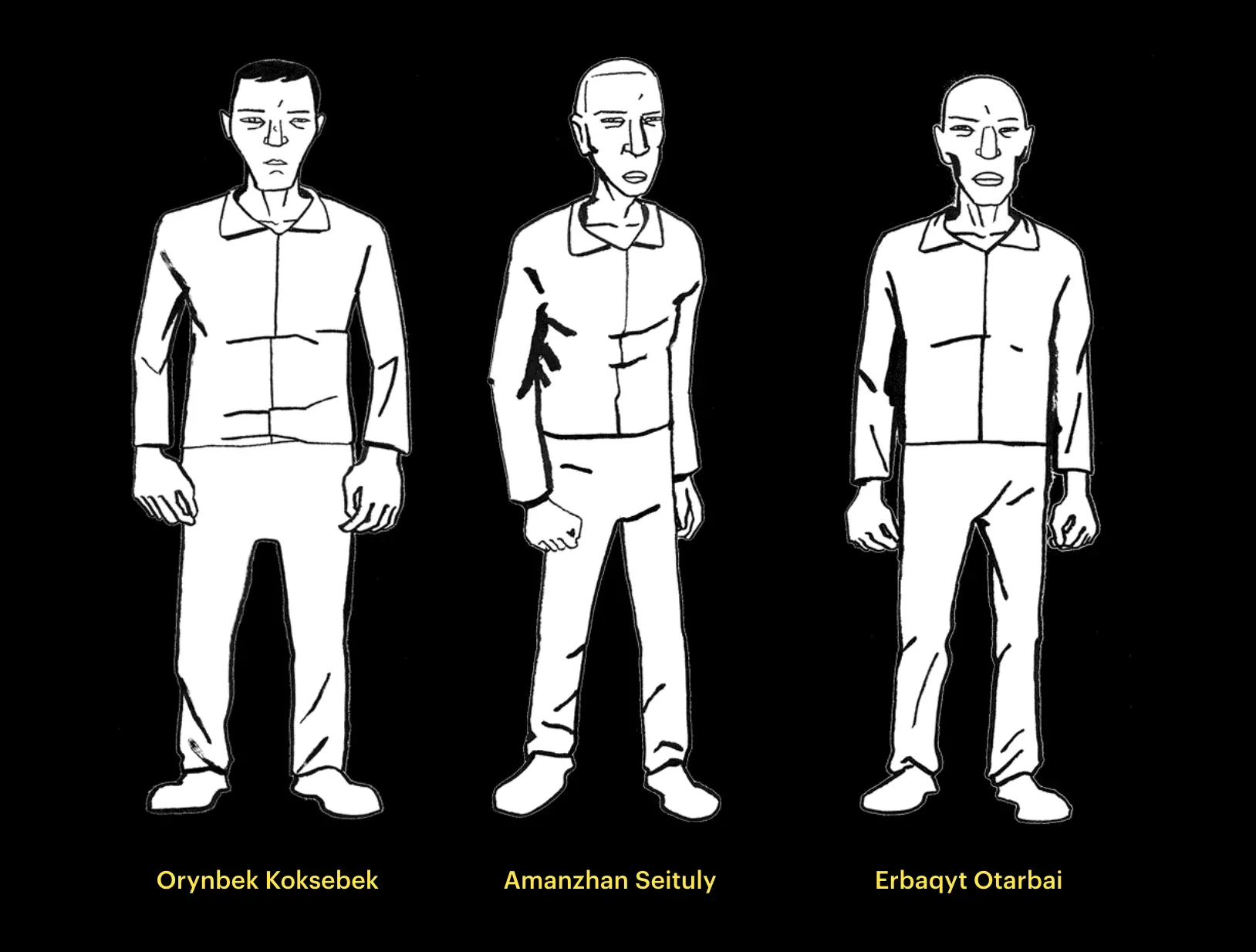
In a series of separate interviews in Kazakhstan, the three men spoke about their detentions, describing the Tacheng camp in detail. The retirement home’s dormitory bedrooms had been transformed into prison cells with triple-locking metal doors and surveillance cameras. Each room had eight barracks-style bunks, but there were often not enough beds for everyone.
In November, when Otarbai arrived, the camp was mostly empty. By the next month, when Koksebek joined him, the adjacent rooms began to fill. Daily classes began. Detainees spent ten hours in a classroom: four hours each in the morning and afternoon, and two hours of review at night. Seituly preferred to sleep on the floor to warm himself against the underfloor heating.
“The light is always on,” Otarbai said. “You can’t see your own shadow.”
Each day, guards woke the detainees around 6:30 a.m. Beijing time—two hours ahead of their local time zone. “We would sing the Chinese Red songs every morning, every day,” Otarbai said.
Koksebek, the herder, didn’t speak Chinese, and found it difficult to recite the national anthem and other patriotic songs that detainees were forced to learn. As punishment, he did stints in solitary confinement. Otarbai spent hours in their cell teaching Koksebek the songs by heart, one syllable at a time. “I can say he taught me Chinese,” Koksebek said.
Every morning, guards delivered meagre rations of vegetables and rice. The students received meat rarely, and Koksebek was concerned that it was not halal. For several hours each day, they watched state-produced news broadcasts, documentaries, and speeches by President Xi Jinping. Video cameras kept them under constant surveillance. In time, Otarbai learned the stories of his cellmates. Some had downloaded WhatsApp, like he had. Others had bought property in foreign countries. They shared stories and gossip while completing exercises in their Chinese workbooks or watching TV. The detainees were never allowed outside. “Of course, you are bored,” Otarbai said. “But they wouldn’t leave us alone.”
In November, when Otarbai arrived, the camp was mostly empty. By the next month, when Koksebek joined him, the adjacent rooms began to fill. Daily classes began. Detainees spent ten hours in a classroom: four hours each in the morning and afternoon, and two hours of review at night.
“After breakfast, we would go to classes, and then we would study until the evening,” Otarbai said.
Iron bars divided the classroom: students on one side and teachers on the other, flanked by rifle-wielding guards. Once the students were in the room, the door was locked. Each classroom accommodated eighty to ninety students. “Old people with vision problems would sit at the front,” Otarbai recalled. “The youngest ones—as young as eighteen—would sit at the back.”
Students were divided into different classes. Koksebek, who had a second-grade education, was in the lowest level, where he learned basic Chinese words and numbers. For high-school and college graduates, like Otarbai and Seituly, classes focussed on political indoctrination and, to an obsessive degree, they said, the dangers of Islam. “ ‘Religion is like an opium,’ they tell us,” Seituly recalled. “They talk about jihadists. They say that if someone doesn’t smoke or drink alcohol, they might be having extremist thoughts.”
Although it was forbidden to talk with classmates, Otarbai recognized prominent local people in his class, including imams, intellectuals, and former mayors. “There were a lot of influential people,” he said. Just as he was at the pretrial detention center, Otarbai was a surly prisoner, demanding his release and better treatment for him and his cellmates. As punishment, he frequently spent time in solitary confinement, in a squalid cell too small to lie down in. During one interrogation, guards forced him to strip, drenched him in water, and beat him. Another time, he was shocked with an electric prod. Detainees at other camps described similar experiences.
Toward the end of December, Otarbai began to experience sharp pains in his side. On January 1st, while he was singing the national anthem, during the weekly flag-raising ceremony, the pain became unbearable. He sat down and asked for a doctor. Although skeptical at first, the camp staff eventually called an ambulance.
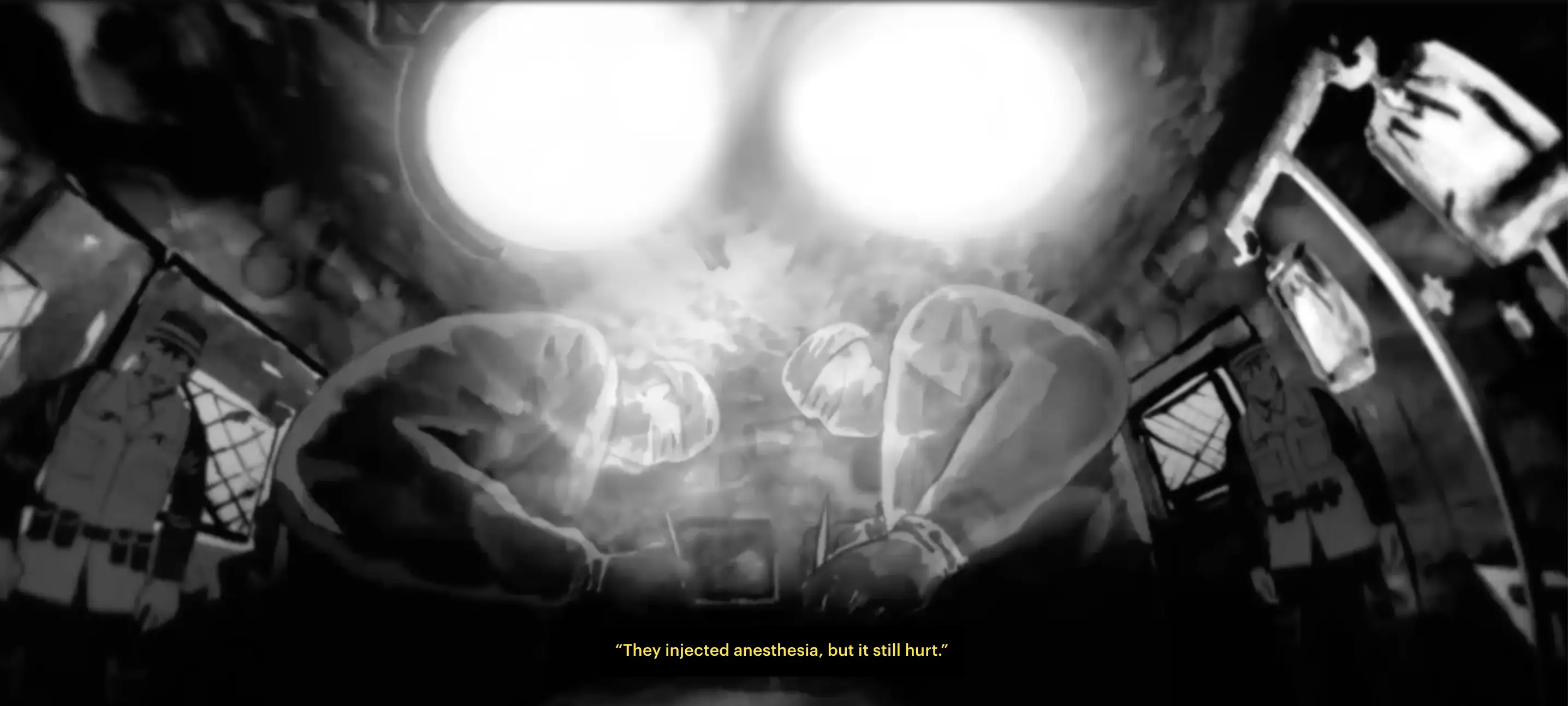
“I shouted because of the pain, and they tied my hands down.”
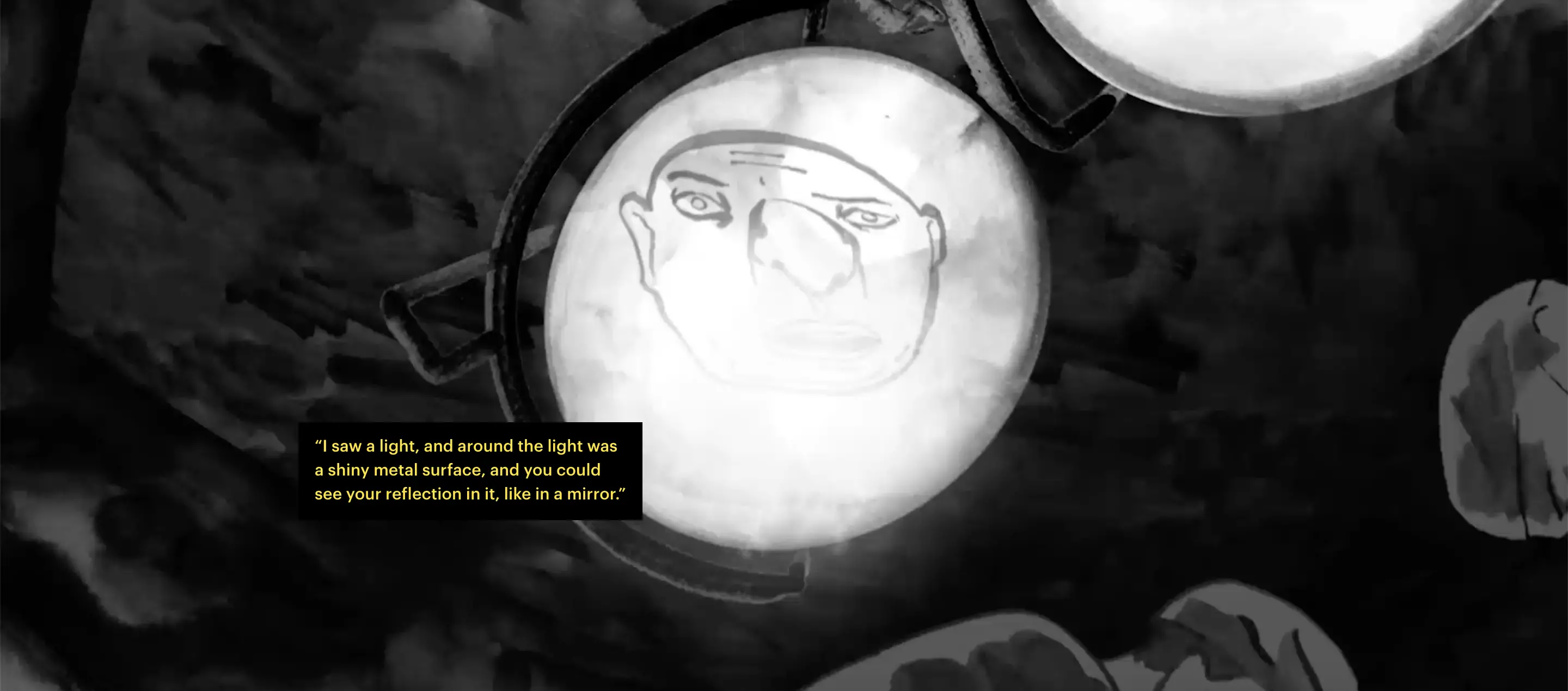
“I saw them pull out my appendix. I was screaming. Nobody cared. A guard approached me and said, ‘You won’t die, and, even if you die, no one will know about it.’"
Otarbai spent fifteen days in Tacheng’s regional hospital recovering from an appendectomy. Guards watched him constantly. After he returned to the camp, he relied on Koksebek, the herder, to bring him food and massage his limbs. The men began calling each other “brother.” Each assured the other he soon would be released.
In 2018, new detention camps sprang up across Xinjiang. According to satellite-photo analyses by the Australian Strategic Policy Institute, the square footage of suspected camps in Xinjiang more than doubled that of the year before. Former detainees described striking similarities in the design of the camps. Door-locking systems, furniture, color-coded uniforms, and classroom layouts were often virtually identical from camp to camp.
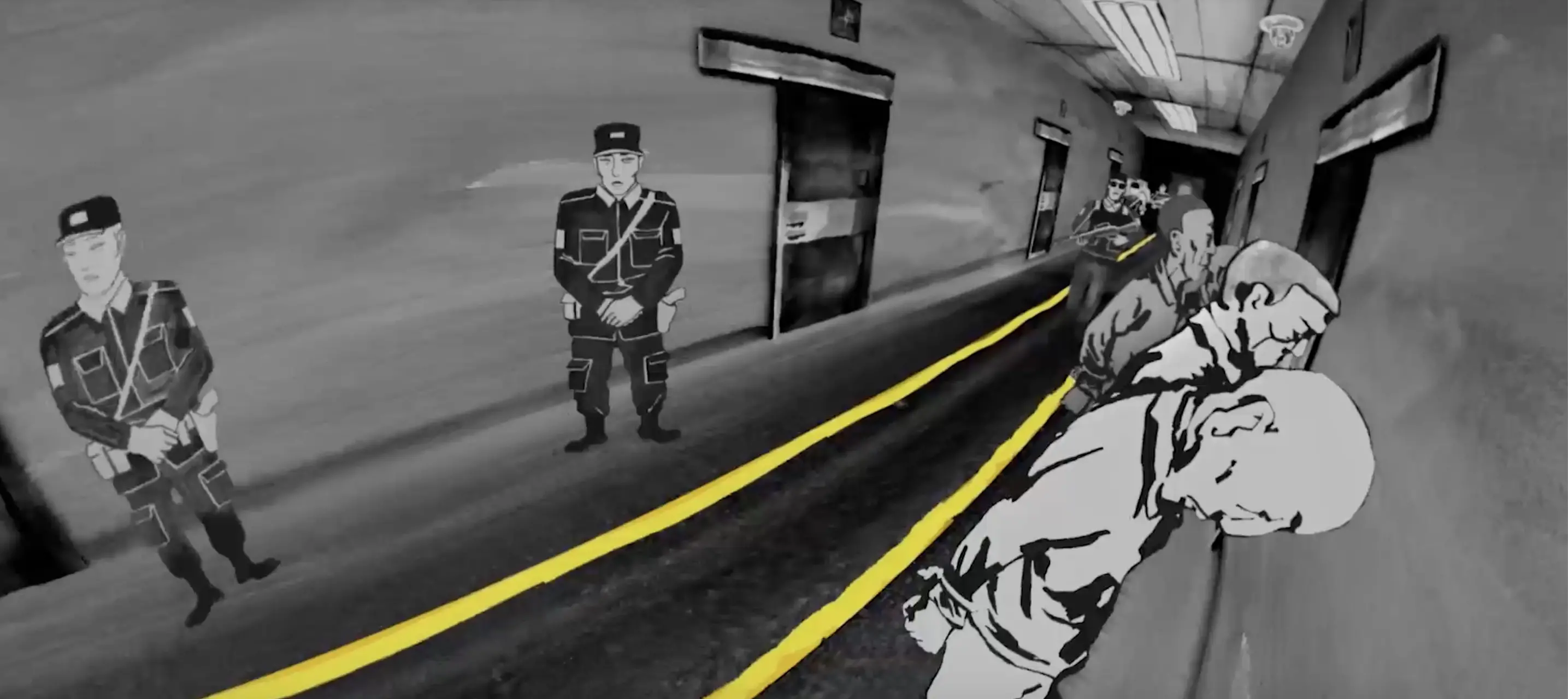
Several detainees in Tacheng, and at other camps, described two yellow lines that were painted on the floors of hallways inside the buildings, to direct inmates and guards around the compound. One day in March, the three Kazakh men and their cellmates were ordered to line up in the hall. Rumors circulated that those staying behind would be freed, and those being transferred would be imprisoned permanently. “They took us outside, four hundred of us, group by group,” Seituly recalled.
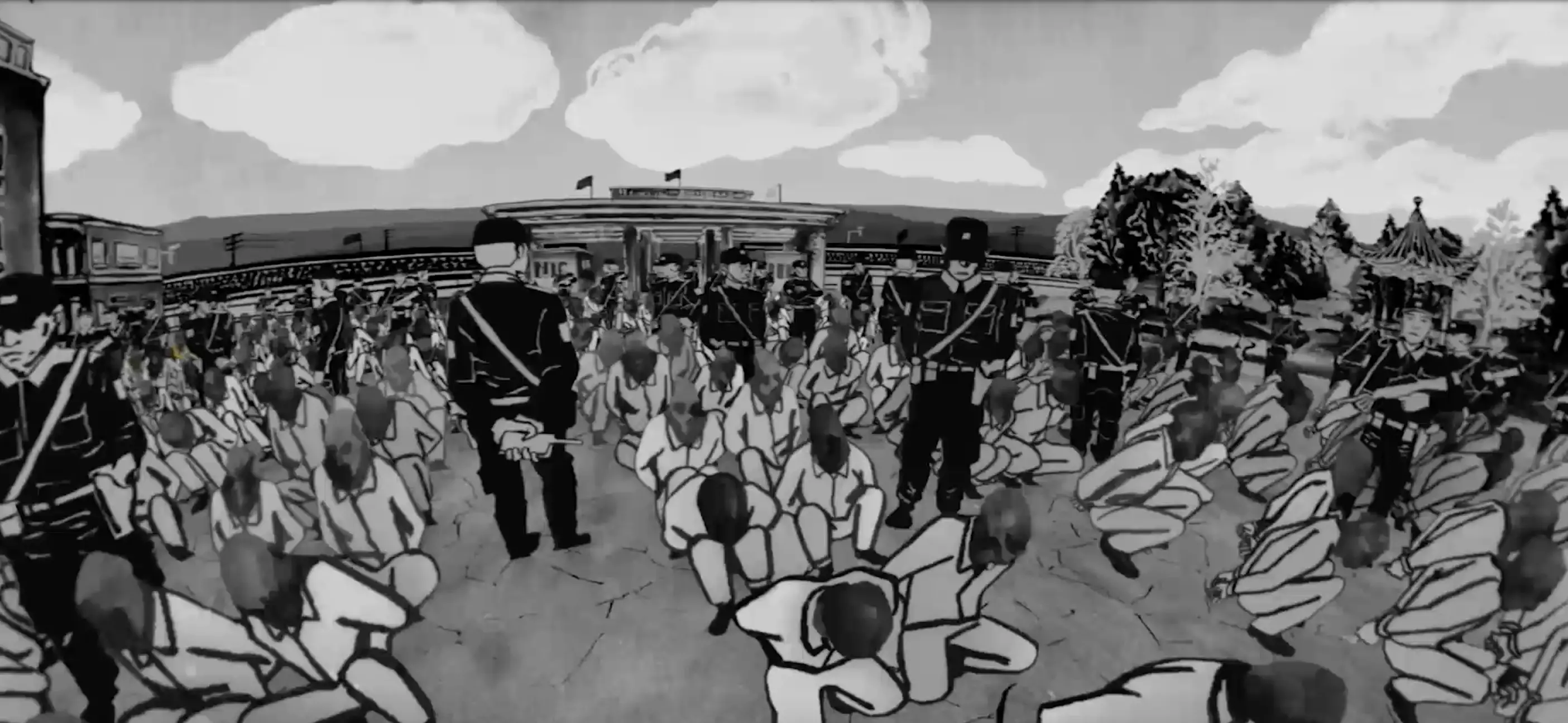
In the yard, the men were ordered to squat as policemen and guard dogs circled them. The police placed hoods over the prisoners’ heads and led them, in pairs, to waiting buses. “They had rifles and were yelling at us. Then they put hoods on us. Like the Second World War. Like the fascists dealing with the Jews,” Seituly said. “We thought they were going to shoot us there.”
The men were driven to a newly built camp a few miles away.
Several weeks later, on April 12th, after many days of intense interrogations, Koksebek and Seituly, both Kazakhstani passport holders, were released. Although Seituly had heard of Koksebek from other cellmates, the day they were set free was the first time they met face to face. They were driven to the border with two other Kazakhstani citizens and allowed to cross. Otarbai, whose Kazakhstani citizenship had not been finalized when he entered China, remained imprisoned. Before their release, Otarbai had implored Seituly to contact his family if the businessman got out first. Seituly promised to try.
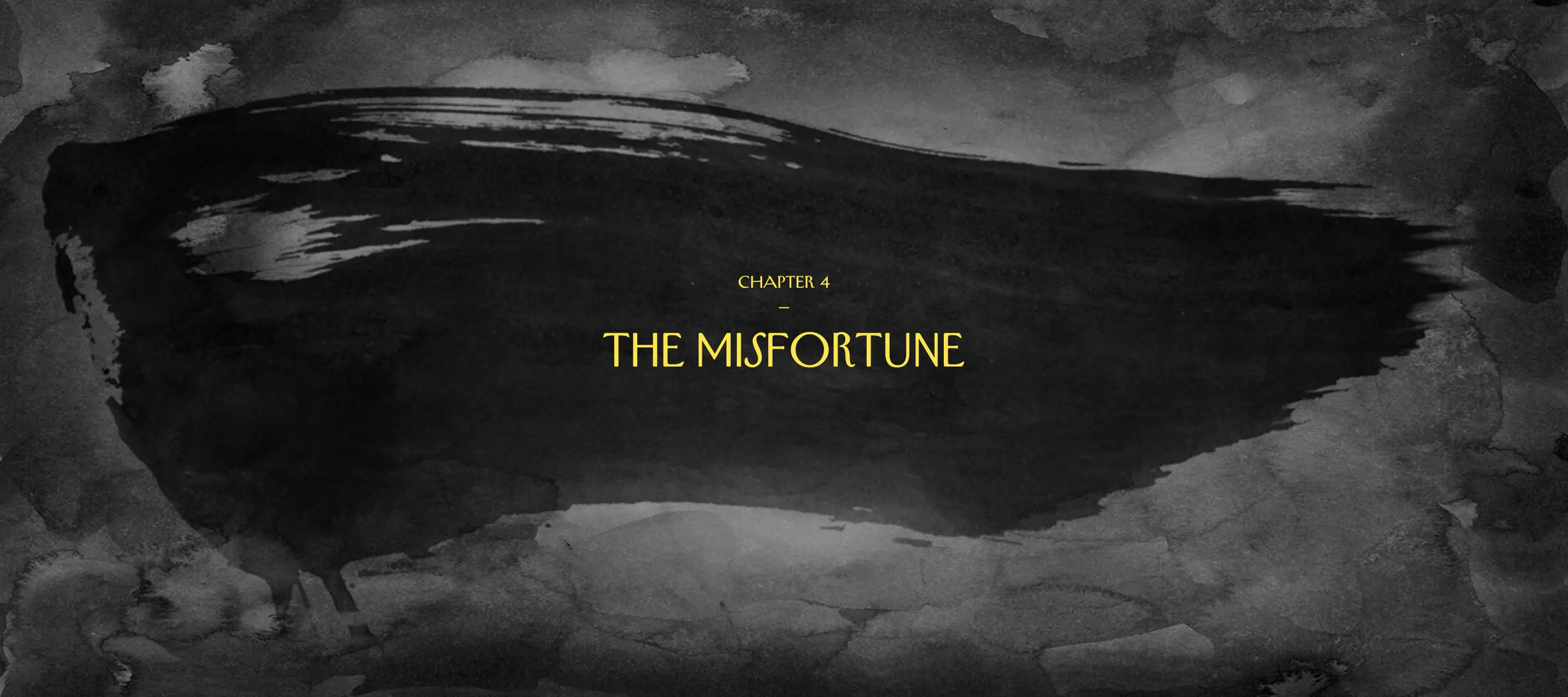
On January 1, 2018—the same day that Otarbai was taken to the hospital for an appendectomy—more than a thousand people gathered at a flag-raising ceremony in a square outside the mayor’s office in Akkoi Farm to hear Aynur, the retired teacher, deliver a public confession. An employee at her former school made Aynur write out her statement in Chinese.
In 2016, flag-raising ceremonies in Xinjiang became mandatory; every family had to send a representative. Absence was considered a black mark on a household, and was used as a pretext for interrogation. Like the “struggle sessions” of the Cultural Revolution—public humiliations of landowners and other class enemies—confessions at flag-raising ceremonies in Xinjiang made an example of those whose thinking had been polluted.
Before she spoke, Aynur stood by herself under a large flagpole while the Chinese flag was raised. Then she explained that, because she was unable to control her husband, he had become involved with terrorists, and that this was why he was living in the camp a few miles down the road, with around five thousand other detainees. When Aynur finished, others rose to give speeches praising the Party. Although she had given brief confessions at previous ceremonies, she’d never been forced to call her husband a terrorist. Afterward, relatives in her village started avoiding her. Former colleagues from her old school stopped saying hello when they saw her on the street. “I felt like a criminal in front of all those people,” she said. “It was not a good feeling.”
A few days later, a camp administrator visited Aynur. The official said that Kokteubai was in the hospital. He’d had a cardiac event. She was ordered to go to the camp hospital to take care of him as he recovered, but cameras monitored them throughout her visit. “If I attempted to talk to him, a voice would come over the loudspeaker and tell us to stop,” she said. This was the third time that Kokteubai had been hospitalized for heart problems during his detention.
In April of 2018, seven months after his detention began, Kokteubai was released, likely owing to poor health. When he left the camp, he could barely walk. The authorities made Aynur sign a paper pledging to be responsible for her husband’s continuing education. He began attending classes in Akkoi Farm with his wife. One day, a local official showed Kokteubai a photo of his daughter, claiming that she was a member of a terrorist group in Kazakhstan. According to multiple former detainees, such practices were used to intimidate or extract information about relatives living abroad. The stress caused Aynur to begin menstruating again, years after the onset of menopause. Almost a year after Kokteubai’s release, the couple was granted permission to cross back into Kazakhstan. A year and a half had passed. Their youngest son was now ten years old.
Aynur refers to her husband’s detention as “the misfortune.” Before his arrest, her life had other partitions. She had once divided it into the time before she was married, followed by the time before she had children, and then the time before her family moved to Kazakhstan. Now the misfortune cleaved her life apart.
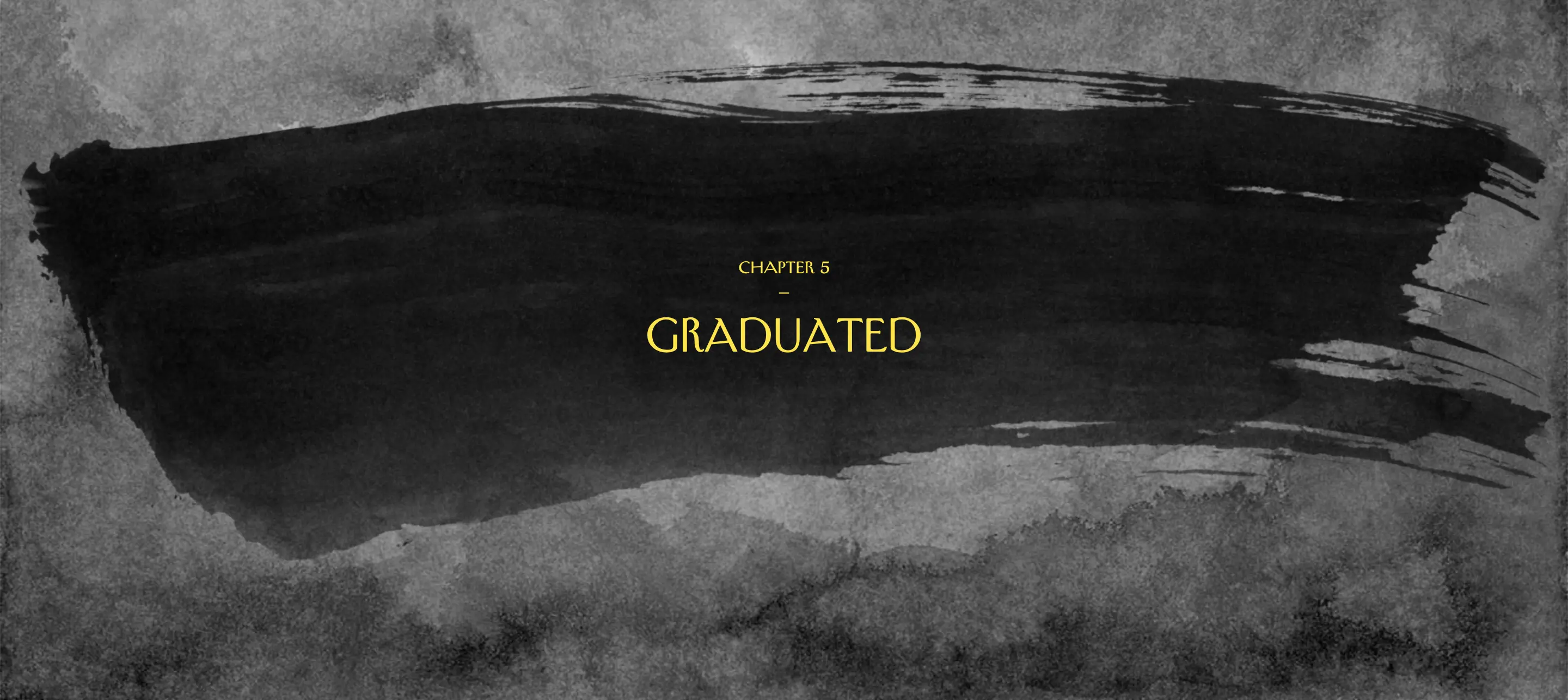
At thousands of checkpoints and convenience stations in Xinjiang, police have collected DNA samples, voice recordings, fingerprints, and iris and facial scans of residents. Throughout the region, people’s homes are marked with QR codes linked to information about each resident. Mandatory smartphone apps monitor citizens’ movements and private messages. Chinese tech companies including Huawei have tested facial-recognition software capable of identifying Uighurs in a crowd. (Huawei claims that a third-party company used its services for testing.)
After years of first denying the facilities’ existence, then claiming that they had closed, Chinese officials now say the camps are “vocational education and training centers,” necessary to rooting out “extreme thoughts” and no different from correctional facilities in the United States or deradicalization centers in France. “Respecting and protecting human rights in accordance with China’s Constitution and law is strictly observed in these centers,” the Chinese consulate in New York said, in response to a request for comment. “The trainees who received education and training for deradicalization purposes have graduated, found stable jobs with the help of the government, and are living a happy life.”
In the spring of 2018, after Koksebek and Seituly were released, Otarbai was transferred back to the former retirement home where all three Kazakh men were initially detained. That fall, in an improvised courtroom inside the camp, Otarbai was convicted and sentenced in a pro-forma process that only vaguely resembled a trial. There was no defense; a representative from his old neighborhood administration read out a verdict stating that he “has been confirmed to have used WhatsApp, and is thus given a seven-year sentence.”
During this time, the camp was growing. According to an analysis of satellite photos, the facility had expanded fivefold since Otarbai was first held there, in 2017, and construction had begun on an approximately twenty-thousand-square-foot factory and warehouse. In November, Otarbai “graduated” from his studies and joined other detainees on the factory floor producing children’s clothing.
A recent BuzzFeed News investigation found more than a hundred facilities in Xinjiang where factories abutted suspected camps or prisons. A government program called Xinjiang Aid has also transferred more than a hundred and fifty thousand “surplus rural workers” to jobs outside the region since 2018. Chinese officials claim that the laborers are migrant volunteers, not detainees. But one notice described the conditions under which the migrant laborers live and work as “concentrated, closed-off, military-style management.” A report issued by members of the U.S. Congress in March, 2020, said that top American corporations, including Nike and Coca-Cola, are suspected of benefitting from forced labor in factories in Xinjiang. Both companies maintain that they perform regular compliance inspections to ensure they are not making use of forced-labor practices.
Official claims that camp populations are declining may therefore be accurate, as detainees are increasingly sent to work in factories and on farms, or else sentenced and transferred to conventional prisons. At least three hundred thousand more people have received formal prison sentences between 2017 and 2019 than in typical previous years, according to an analysis of government documents, public sentencing records, and testimonies conducted by Gene Bunin, the founder of the Xinjiang Victims Database. In 2018, family members of some detainees in Xinjiang learned that their relatives were now serving long prison sentences for offenses such as “propagating extremism” (fourteen years) and “picking quarrels and provoking trouble” (nineteen years).
Firsthand descriptions of criminal trials in Xinjiang are rare. Amirken, the Kazakh hairdresser who married into a prominent religious family, told me that she attended the trial of her brother-in-law, Nurlan Pioner, an imam in the Altai Mountains near Mongolia. For years, Pioner had avoided trouble with authorities. He received training and a certificate from the state-run madrasa in Ürümqi and worked closely with Party officials, who approved his Friday-night sermons and his scholarly work translating religious books from Arabic into Kazakh. Nevertheless, Pioner was detained in June, 2017, and put on trial a year later. His family received a twenty-three-page prewritten judgment of his case. When the proceedings began, two guards with rifles carried Pioner into the courtroom in a chair. The accused was wearing a blue prison uniform that was soiled with urine. He appeared malnourished and was unable to walk; he spoke incoherently. The judge read the prewritten verdict. It said that Pioner was arrested for “gathering a crowd to instigate social disorder; taking advantage of extremism to hold back law enforcement; [and] illegally obtaining materials which propagate [an] extremist ideology.” He was sentenced to seventeen years in prison. According to researchers, Pioner’s case reflected the criminalization of religious practice in Xinjiang.
A month after his conviction, Pioner was temporarily released into medical house arrest. While detained, he had developed upper- and lower-limb amyotrophy and lost the ability to control his body. “He had become almost a vegetable,” Amirken recalled. “He couldn’t hear. He couldn’t talk.” Fearing that they, too, would be arrested, Amirken and her family fled to Kazakhstan in January, 2018. Ten months after they left, law-enforcement officers returned Pioner to prison to serve out the rest of his sentence.
In December, 2018, just a few months after his sentencing, Otarbai was abruptly released into a halfway home for recently freed detainees. The reason remains a mystery, but his former cellmates Koksebek and Seituly, from the relative safety of Kazakhstan, had made statements calling for his release. Six months later, after more than two years away from his family, Otarbai crossed into Kazakhstan. His wife and two children, aged nine and four, were waiting at the house he had built for them, in a small town outside Almaty, Kazakhstan’s largest city. His younger son, Nurtal, didn’t recognize him when he came home. “Who’s this uncle come to our house?” the boy asked his mother.
In 2018 and 2019, I made several trips to Kazakhstan to meet people who had witnessed the rise of Xinjiang’s security state. I spoke with a dozen former detainees of camps; I met dozens more whose family members had been detained, imprisoned, or disappeared. In December of 2019, before covid-19 restricted travel, I met Otarbai in a threadbare hotel room in a small, snow-covered town an hour outside Almaty.
Today, Otarbai suffers from chronic pain and memory loss, which he attributes to his long imprisonment and the torture he suffered. Yet he was the funniest and most lighthearted of the former detainees that I met. While imprisoned, he decided that, if he were ever released, he would raise his children in an atmosphere of total freedom. “Almost all the doors of the furniture are broken now,” he told me. “But I never scold them, because I really understand what prison is. I want them to be free of everything.”
Otarbai recalled that, when he was in the camp, inmates would sing songs to cheer one another up. He became well known for his singing voice, and his teachers would sometimes ask him to serenade his fellow-students. “You aren’t allowed to sing in Kazakh or Uighur, but you can in Mongolian, Chinese, or English,” he explained. “I have a favorite song by a Mongolian singer. The song goes, ‘I grew up on a vast grassland, I grew up freely, on the land of my ancestors, and I was nurtured by it.’ When I would sing these kinds of songs, my classmates would feel happy.” Then, with a voice as bright as a mountain stream, he sang it.
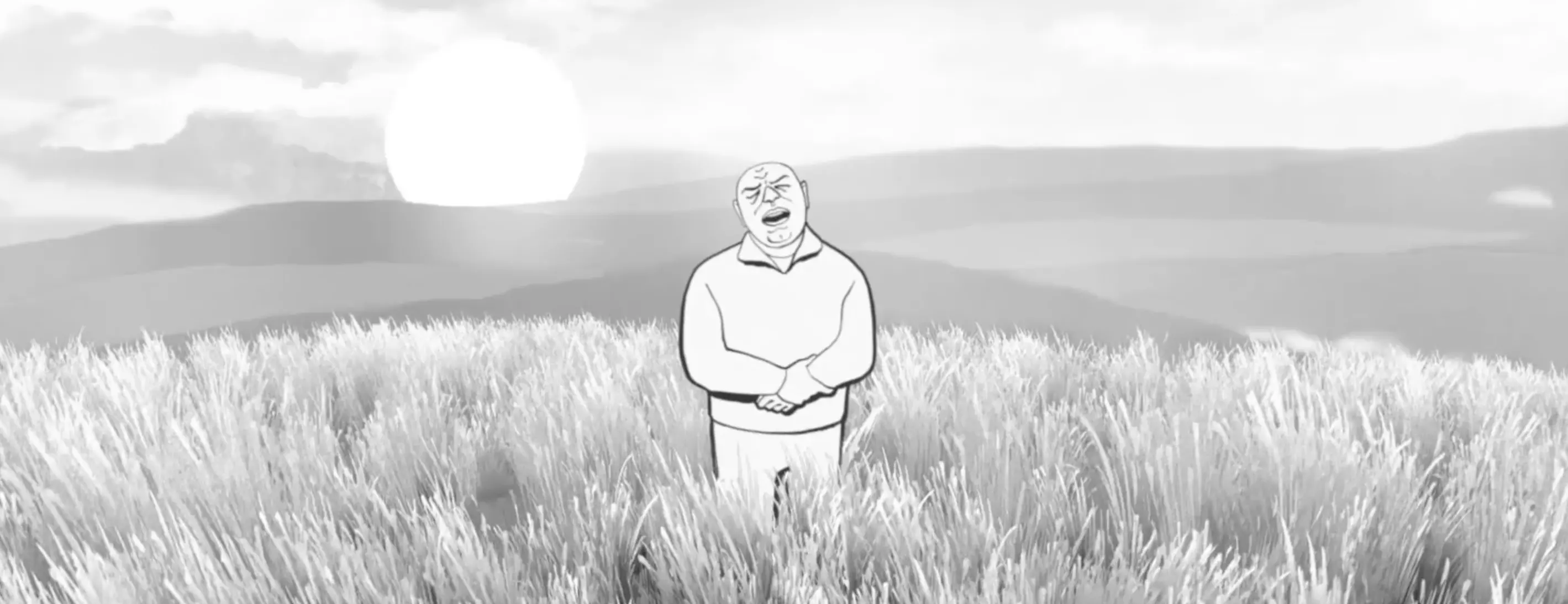
Reporter Ben Mauk Animation Director Sam Wolson Artist Matt Huynh Producers Ben Mauk, Sam Wolson, Monica Racic, Sandra Garcia Executive Producers Soo-Jeong Kang, Monica Racic Art Director Sandra Garcia Designers Sandra Garcia, David Kofahl Developers David Kofahl, Rekha Tenjarla Story Editors Monica Racic, David Rohde Fact Checker Linnea Feldman Emison Copy Editor S. Whitney Holmes Additional Production and Research Naib Mian Lead Animator and Technical Supervisor Nicholas Rubin/Dirt Empire Assistant Animator Oliver Carr Lead Compositor and Color Grader Noel Paul VFX Artist Eddy Moya Artist Assistant M. J. Steele Singer Erbaqyt Otarbai Photographs by Sam Wolson; Ben Mauk (Aynur)










